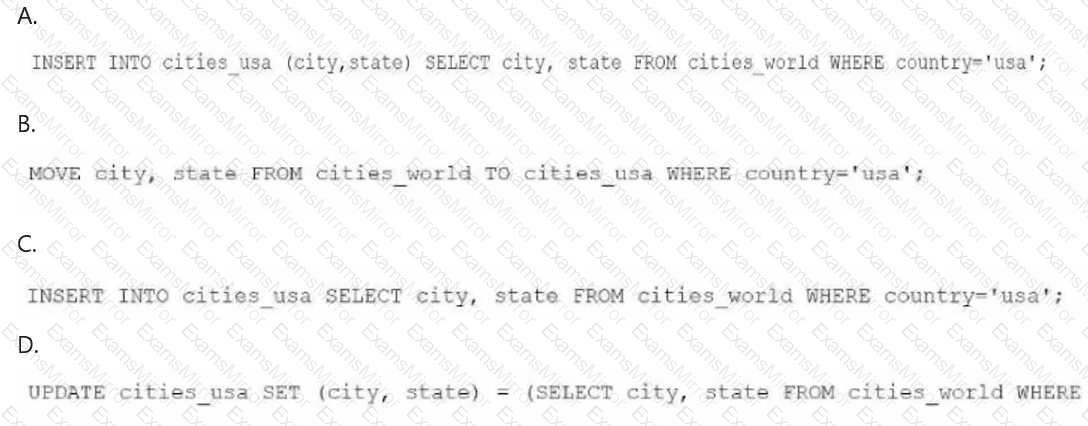Cyber Monday Special Limited Time 70% Discount Offer - Ends in 0d 00h 00m 00s - Coupon code = getmirror
Pass the Amazon Web Services AWS Certified Data Engineer Data-Engineer-Associate Questions and answers with ExamsMirror
Exam Data-Engineer-Associate Premium Access
View all detail and faqs for the Data-Engineer-Associate exam
526 Students Passed
84% Average Score
96% Same Questions
A company uses AWS Key Management Service (AWS KMS) to encrypt an Amazon Redshift cluster. The company wants to configure a cross-Region snapshot of the Redshift cluster as part of disaster recovery (DR) strategy.
A data engineer needs to use the AWS CLI to create the cross-Region snapshot.
Which combination of steps will meet these requirements? (Select TWO.)
A data engineer wants to orchestrate a set of extract, transform, and load (ETL) jobs that run on AWS. The ETL jobs contain tasks that must run Apache Spark jobs on Amazon EMR, make API calls to Salesforce, and load data into Amazon Redshift.
The ETL jobs need to handle failures and retries automatically. The data engineer needs to use Python to orchestrate the jobs.
Which service will meet these requirements?
A company stores customer data in an Amazon S3 bucket. Multiple teams in the company want to use the customer data for downstream analysis. The company needs to ensure that the teams do not have access to personally identifiable information (PII) about the customers.
Which solution will meet this requirement with LEAST operational overhead?
Two developers are working on separate application releases. The developers have created feature branches named Branch A and Branch B by using a GitHub repository's master branch as the source.
The developer for Branch A deployed code to the production system. The code for Branch B will merge into a master branch in the following week's scheduled application release.
Which command should the developer for Branch B run before the developer raises a pull request to the master branch?
A data engineer must orchestrate a data pipeline that consists of one AWS Lambda function and one AWS Glue job. The solution must integrate with AWS services.
Which solution will meet these requirements with the LEAST management overhead?
A company has as JSON file that contains personally identifiable information (PIT) data and non-PII data. The company needs to make the data available for querying and analysis. The non-PII data must be available to everyone in the company. The PII data must be available only to a limited group of employees. Which solution will meet these requirements with the LEAST operational overhead?
A company plans to use Amazon Kinesis Data Firehose to store data in Amazon S3. The source data consists of 2 MB csv files. The company must convert the .csv files to JSON format. The company must store the files in Apache Parquet format.
Which solution will meet these requirements with the LEAST development effort?
A data engineer needs to create an Amazon Athena table based on a subset of data from an existing Athena table named cities_world. The cities_world table contains cities that are located around the world. The data engineer must create a new table named cities_us to contain only the cities from cities_world that are located in the US.
Which SQL statement should the data engineer use to meet this requirement?

A company ingests data from multiple data sources and stores the data in an Amazon S3 bucket. An AWS Glue extract, transform, and load (ETL) job transforms the data and writes the transformed data to an Amazon S3 based data lake. The company uses Amazon Athena to query the data that is in the data lake.
The company needs to identify matching records even when the records do not have a common unique identifier.
Which solution will meet this requirement?
A company stores customer records in Amazon S3. The company must not delete or modify the customer record data for 7 years after each record is created. The root user also must not have the ability to delete or modify the data.
A data engineer wants to use S3 Object Lock to secure the data.
Which solution will meet these requirements?
TOP CODES
Top selling exam codes in the certification world, popular, in demand and updated to help you pass on the first try.
